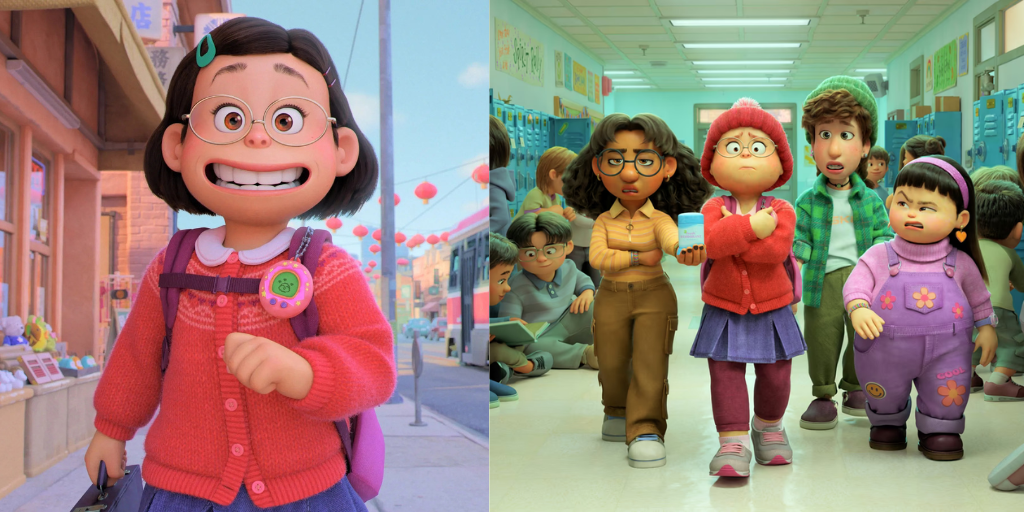
The ending of Turning Red is built around Mei’s difficult decision about what to do with her red panda spirit. Throughout the movie, the panda represents both a curse and a gift.
It is tied to her family’s ancestry, originating from her ancestor Sun Yee, who gave her descendants the power to transform into red pandas during times of strong emotion. Traditionally, the red panda is sealed away within a talisman during a ritual, allowing family members to live “normal” lives free from the chaos it brings.
Mei’s panda first emerges in the middle of her teenage struggles with puberty, independence, and growing friendships. At first, she panics and wants to suppress it.
But as the story progresses, she begins finding joy in her panda form, especially when it helps her bond with her friends and express parts of herself she used to hide. Her mother, Ming, however, sees it as a dangerous burden, insisting it must be sealed away to maintain order and reputation.
This cultural and generational conflict reaches a boiling point during the ritual at the climax. While Mei is expected to lock away her panda, she realizes it has become part of her identity.
To give it up would mean silencing her individuality, her creativity, and her independence. Mei shocks her family by refusing to go through with the ritual, breaking tradition, and choosing to keep her panda spirit.
But this choice creates a massive confrontation. Ming grows furious, losing control of her own red panda form, which manifests as a towering, kaiju-sized creature. She storms into the concert arena where Mei and her friends are trying to raise money, causing chaos.
Also read: Austin Butler Net Worth: From Disney Beginnings to Hollywood Royalty
This moment symbolizes how family expectations, when left unchecked, can grow larger than life, threatening to crush individuality.
The Battle Between Mother and Daughter
The conflict between Mei and Ming is both literal and symbolic. Ming’s massive panda rages through the stadium, expressing both her overprotective nature and her inability to let Mei grow on her own. Mei, now fully embracing her smaller red panda, confronts her mother directly.
Their fight is visually spectacular, but the heart of the scene lies in emotion. Mei’s defiance is not about rejecting her mother; it’s about standing proudly in who she is becoming.
She tells Ming that she is changing, that she is no longer just the obedient daughter but someone creating her own path. Ming, however, sees this as rebellion and a rejection of family.
The other women in the family, including Mei’s aunts and grandmother, join together to contain Ming’s rampage. They know what it means to seal away the panda; they have all done it themselves.
They perform another ritual, trying to pull Ming into the astral plane where the red panda spirits can be contained. Mei joins them, helping her mother through this difficult process.
Inside the spirit world, Mei sees a younger version of Ming, deeply hurt by the pressure she once faced from her own mother. This moment reframes Ming not as a villain, but as someone shaped by generational expectations and cultural duty.
Mei comforts her, showing that healing can come not from obedience, but from understanding and compassion. Ming admits her fears of losing Mei, confessing that her strictness comes from love but is expressed in harmful ways.
Mei’s Choice: Keeping the Panda
After reconciling with Ming, Mei faces the final decision about whether to seal her own panda away like all the other women in her family. The ritual succeeds for Ming, whose panda is locked within jewelry once again.
But when it comes to Mei, she firmly decides to keep her panda. Unlike her ancestors, she does not view it as a curse but as an expression of her true self.
This decision is the culmination of her character arc. At the start of the film, Mei worked tirelessly to be the “perfect daughter,” obedient, high-achieving, and controlled. But her panda embodies her suppressed feelings: her attraction to boys, her excitement for new things, her humor, her anger, and her creativity.

By keeping her panda, Mei declares to herself and her family that she refuses to lock away vital parts of who she is.
Her family, though initially shocked, accepts her choice. Ming admits that she may not understand everything about Me, but promises to support her anyway.
This acceptance represents generational healing: the acknowledgment that traditions may evolve, and love means allowing younger generations to grow into themselves.
The Epilogue: Balance Between Family and Independence
The film concludes with Mei living openly with her panda, integrating it into her daily life. She still helps at the family temple with her parents, but also embraces time with her friends and her individuality.
By balancing both aspects, she shows that choosing independence does not mean rejecting family. It means bringing her authentic self into the family dynamic, reshaping it for future generations.
Ming, now more accepting, begins to soften her hold, showing small but meaningful signs of change in her relationship with Mei. Their bond, though still evolving, grows stronger because honesty has replaced fear.
The final scenes reflect this harmony, showing Mei happy, confident, and comfortable in her skin, while Ming learns that letting go is also a form of love.
The panda is no longer a symbol of shame or something to hide. It represents Mei’s growth, her heritage, and the beauty of embracing imperfections. The film closes on a hopeful note, suggesting that family bonds grow stronger not by enforcing sameness but by accepting differences.
Why the Ending Resonates
The ending of Turning Red resonates because it reflects the universal struggles of adolescence. Mei’s panda is a metaphor for puberty, cultural expectations, and the emotions that come with growing up. For many viewers, it mirrors the experience of balancing personal identity with family responsibility and tradition.
The confrontation with Ming highlights the importance of generational dialogue. Ming is not portrayed as evil but as someone deeply shaped by her own struggles.
The resolution comes not through destruction but through empathy and reconciliation. This makes the message powerful: change within families comes when both sides listen and accept one another.
By keeping her panda, Mei sends a clear message about embracing all parts of oneself, the messy, exciting, scary, and funny. Where many stories might show characters suppressing what makes them different to “fit in,” Turning Red celebrates authenticity.
Finally, the story’s ending resonates because it balances humor, heart, and cultural specificity. While it centers around a Chinese-Canadian family in Toronto, its themes of adolescence, mother-daughter relationships, and self-acceptance are universal.
Every generation watching can see themselves in either Mei’s defiance, Ming’s fear, or the family’s eventual healing.
Also read: KATSEYE’s “Gabriela” Surges Back Onto Billboard Hot 100, Achieves Career-Best Ranking








